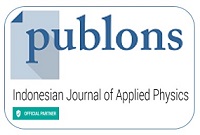Evaluation of Bogie Bolster Centre Plate and Side Bearing under Vertical Static Loads through Finite Element (FEA) Modelling
Abstract
The bolster is one of the main structural elements in railway bogies, playing the central role of transmitting vertical and dynamic loads from the train body to the wheel-sets. The mechanical behavior of an ASTM A148 Grade 80-50 material bolster under vertical static loading is examined in this work. This simulation is analyzed by applying the Finite Element Analysis (FEA) using student version software with nonlinear static analysis, which was run with a tetrahedral mesh and Newton-Raphson iteration. There are three variables, respectively, two variables as dependent, such as Von Misses Stress (VMS) and total deformation resulting from the loading condition. Then, the independent variable is a loading value based on the AAR M-202 standard. In this work, three values of loading condition were carried out, such as P1 = 536010.7 N, P2 = 854058.8 N, P3 = 1027500 N respectively. The result of the simulation shows that the maximum average stress in the critical area is 305.58 MPa, which is still less than the yield strength of the material at 390 MPa. The maximum elastic deflection of 0.102 mm is well within the AAR M-202 standard allowable values. In conclusion, bolster bogie based on ASTM A148 Grade 80-50 has reliability for static loading and is available with a safety factor according to the AAR M-202 standard.
Keywords
Full Text:
PDFReferences
A. W. Evans, “Fatal train accidents on Europe’s railways: An update to 2019,” Accid Anal Prev, vol. 158, p. 106182, Aug. 2021, doi: 10.1016/j.aap.2021.106182. [2] S. Zhu, C. Cai, and W. Zhai, “Interface Damage Assessment of Railway Slab Track Based on Reliability Techniques and Vehicle-Track Interactions,” J Transp Eng, vol. 142, no. 10, Oct. 2016, doi: 10.1061/(ASCE)TE.1943-5436.0000871. [3] G. Cai, J. Zhao, Q. Song, and M. Zhou, “System architecture of a train sensor network for automatic train safety monitoring,” Comput Ind Eng, vol. 127, pp. 1183–1192, Jan. 2019, doi: 10.1016/j.cie.2018.04.038. [4] N. Wang, X. Yang, J. Chen, H. Wang, and J. Wu, “Hazards correlation analysis of railway accidents: A real-world case study based on the decade-long UK railway accident data,” Saf Sci, vol. 166, p. 106238, Oct. 2023, doi: 10.1016/j.ssci.2023.106238. [5] B. Dorsey, M. Olsson, and L. J. Rew, “Ecological Effects of Railways on Wildlife,” in Handbook of Road Ecology, Wiley, 2015, pp. 219–227. doi: 10.1002/9781118568170.ch26. [6] S. Qu, J. Wang, D. Zhang, D. Li, and L. Wei, “Failure analysis on bogie frame with fatigue cracks caused by hunting instability,” Eng Fail Anal, vol. 128, p. 105584, Oct. 2021, doi: 10.1016/j.engfailanal.2021.105584. [7] J. Tittel, M. Kepka, and P. Heller, “Static and dynamic testing of a bogie,” IOP Conf Ser Mater Sci Eng, vol. 723, p. 012031, Feb. 2020, doi: 10.1088/1757-899X/723/1/012031. [8] B. Li and Q. Li, “Coupled FEM-DEM modelling of permeability evolution in rough fractured shale during shearing under varying confining pressures,” Journal of Rock Mechanics and Geotechnical Engineering, Apr. 2025, doi: 10.1016/J.JRMGE.2025.03.017. [9] P. A. Dhaware and G. Arunkumar, “Experimental Investigation and Fatigue Analysis of Primary Suspension Spring of Railway Bogies: A Review,” Techno-Societal 2018 - Proceedings of the 2nd International Conference on Advanced Technologies for Societal Applications, vol. 2, pp. 951–963, 2020, doi: 10.1007/978-3-030-16962-6_94. [10] J. L. San Román, C. Álvarez-Caldas, and A. Quesada, “Structural Validation of Railway Bogies and Wagons Using Finite Elements Tools,” Proc Inst Mech Eng F J Rail Rapid Transit, vol. 219, no. 3, pp. 139–150, May 2005, doi: 10.1243/095440905X8844. [11] N. S. Ottosen and H. Petersson, Introduction to the Finite Element Method. 1992. [12] W. Zhao and Y. Zeng, “Comparative study of static strength and fatigue strength tests and simulation analysis of an exit subway bogie frame,” in Third International Conference on Mechanical Design and Simulation (MDS 2023), M. A. Mellal and Y. Rao, Eds., SPIE, Jun. 2023, p. 47. doi: 10.1117/12.2681869. [13] J. Gerlici, G. Vatulia, A. Lovska, Ye. Krasnokutskyi, and S. Solcansky, “The research into the vertical dynamics of the flat wagon loaded with hopper container with consideration of their elastic interaction,” Transportation Research Procedia, vol. 74, pp. 395–402, 2023, doi: 10.1016/j.trpro.2023.11.160. [14] D. Hu, X. Jin, C. Yang, and H. Wang, “Strength analysis of subway bogie frame based on experiment,” in Seventh International Conference on Traffic Engineering and Transportation System (ICTETS 2023), A. R. Ghanizadeh and H. Jia, Eds., SPIE, Feb. 2024, p. 188. doi: 10.1117/12.3016113. [15] J. L. San Román, C. Álvarez-Caldas, and A. Quesada, “Structural Validation of Railway Bogies and Wagons Using Finite Elements Tools,” Proc Inst Mech Eng F J Rail Rapid Transit, vol. 219, no. 3, pp. 139–150, May 2005, doi: 10.1243/095440905X8844. [16] P. Shahidi, D. Maraini, B. Hopkins, and A. Seidel, “Estimation of Bogie Performance Criteria Through On-Board Condition Monitoring,” Annual Conference of the PHM Society, vol. 6, no. 1, Sep. 2014, doi: 10.36001/phmconf.2014.v6i1.2515. [17] J. Dižo, J. Harušinec, and M. Blatnický, “Computation of Modal Properties of Two Types of Freight Wagon Bogie Frames Using the Finite Element Method,” Manufacturing Technology, vol. 18, no. 2, pp. 208–214, Apr. 2018, doi: 10.21062/ujep/79.2018/a/1213-2489/MT/18/2/208. [18] I. Blanari and V. Goanta, “Stress/Strain analysis in the bogie in linear motion,” IOP Conf Ser Mater Sci Eng, vol. 564, no. 1, p. 012048, Oct. 2019, doi: 10.1088/1757-899X/564/1/012048. [19] S. David Müzel, E. P. Bonhin, N. M. Guimarães, and E. S. Guidi, “Application of the Finite Element Method in the Analysis of Composite Materials: A Review,” Polymers (Basel), vol. 12, no. 4, p. 818, Apr. 2020, doi: 10.3390/polym12040818. [20] Y. P. D. S. Depari et al., “Numerical analysis of static loading on bogie frame of the Indonesian High-Speed Train (HST) using EN 13749 with 7 load cases,” 2024, p. 020048. doi: 10.1063/5.0205924. [21] S. D. Iwnicki, S. Stichel, A. Orlova, and M. Hecht, “Dynamics of railway freight vehicles,” Vehicle System Dynamics, vol. 53, no. 7, pp. 995–1033, Jul. 2015, doi: 10.1080/00423114.2015.1037773. [22] S. Wang, P. Wu, Y. Song, C. Liu, Y. Ye, and F. Li, “Vibration environment spectrum investigation of metro bogie frame end,” Eng Fail Anal, vol. 157, p. 107865, Mar. 2024, doi: 10.1016/j.engfailanal.2023.107865. [23] AAR, “AAR Section S Edition,” The Association of American Railroads, 50 F Street, N.W., Washington, D.C. 20001-1564, 2007. [24] R. D. Cook, “Concepts and applications of finite element analysis,” John Wiley & Sons, 2001. [25] I Nyoman Budiarsa, IDG Ary Subagia, I Wayan Widhiada, and Ngakan PG Suardana, “Characterisation of material parameters by reverse finite element modelling based on dual indenters Vickers and spherical indentation,” Procedia Manuf, vol. 2, 2015. [26] S. K. Sharma and A. Kumar, “Dynamics Analysis of Wheel Rail Contact Using FEA,” Procedia Eng, vol. 144, pp. 1119–1128, 2016, doi: 10.1016/j.proeng.2016.05.076. [27] B. M. Nickerson, “Development of an integrated numerical method for the fatigue analysis of railway bogies,” 2017. [28] J. N. Reddy, An introduction to the finite element method. 1993. [29] Y. Wang, J. Xue, X. Zhang, and L. Chen, “Finite Element Analysis and Evaluation of Bogie Frame for Passenger Locomotive based on Reliability,” International Journal of Performability Engineering, vol. 15, no. 1, p. 146, 2019, doi: 10.23940/ijpe.19.01.p15.146155. [30] N. Tao, A. G. Anisimov, and R. M. Groves, “FEM-assisted shearography with spatially modulated heating for non-destructive testing of thick composites with deep defects,” Compos Struct, vol. 297, p. 115980, Oct. 2022, doi: 10.1016/j.compstruct.2022.115980. [31] H. Cui et al., “Destructive testing and simulation for newly designed full-scale high-speed railway box girder,” Constr Build Mater, vol. 328, p. 127112, Apr. 2022, doi: 10.1016/j.conbuildmat.2022.127112. [32] A. Kerebih Jembere, V. Paramasivam, S. Tilahun, and S. K. Selvaraj, “Stress analysis of different cross-sections for passenger truck chassis with a material of ASTM A148 Gr 80–50,” Mater Today Proc, vol. 46, pp. 7304–7316, 2021, doi: 10.1016/j.matpr.2020.12.985
Refbacks
- There are currently no refbacks.
















